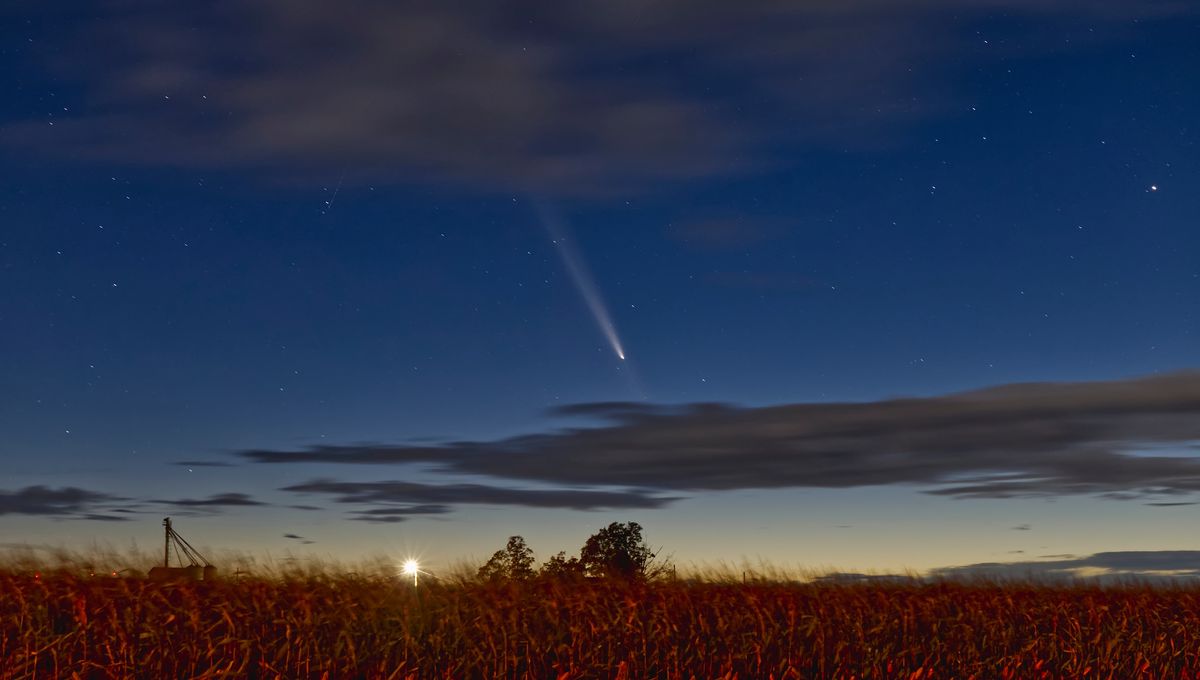
Comet Tsuchinshan-ATLAS is fading fast, but strange as it may seem, the best time to see it is probably still to come. Don’t wait too long, however; miss it over the next fortnight and it won’t come around for another 80,000 years.
The comet officially known as C/2023 A3 (Tsuchinshan-ATLAS) is setting later in the evening every night. That means it will be higher in the sky at sunset, and more importantly at full dark. It will be getting fainter as well, as it moves away from the Sun. However, for those without specialist equipment, the shift into darker skies is likely to more than offset the reduced light reflected off the comet for the next few days, offering the best chance to see the comet. After that, the dark sky advantage will taper off, while the fading will continue.
If you have clear skies this weekend, however, this could be the best comet viewing for Northern Hemisphere observers since 1997, and for those in the south since 2007 (references to the “comet of the century” are Southern Hemisphere erasure).
Comets tend to attract a lot of excitement beforehand, and leave disappointment behind. Many don’t end up being as bright as predicted, but even among those that do, people unversed in the ways of comets seldom witness the display they expect. That’s because comets are brightest when closest to the Sun, as the heat turns ices to gas, carrying dust away from the comet’s body.
The times when bright comets are physically close to the Sun are, with rare exceptions, also when it appears closest to the Sun from our angle.
Consequently, a comet can become dazzlingly bright, but still almost impossible to see. That was the case with Tsuchinshan-ATLAS. The brightest recorded measurement was at magnitude -4 last week. Smaller numbers are better in the astronomical magnitude system, and negative better still. Negative four made the comet as bright as Venus is now. Unfortunately, it was also so close to the Sun as to be invisible without special equipment – and indeed dangerous to seek.
Those who do have suitable instruments have managed some stunning photographs for the rest of us, sometimes including a sharp “antitail”, an optical illusion created by cometary dust that appears to point towards, rather than away from the Sun.
Tsuchinshan-ATLAS has now faded to magnitude 3, but it’s also 34 degrees from the Sun from our perspective. Full night is defined as the time when the Sun is 18 degrees below the horizon, so the comet is finally above the horizon at night. Nevertheless, tonight it will be close enough to the horizon that you will have to look through a lot of atmosphere to see it, even if nothing more solid blocks your view.
Fortunately, Tsuchinshan-ATLAS is still moving fast, getting around three degrees further from the Sun each day. The extra few degrees above the horizon as full dark begins on Saturday and Sunday are likely to give most people the best views, helped by the Supermoon fading.
Tsuchinshan-ATLAS is just north of the celestial equator, so most of the planet will at least have a decent chance to see it. Look southwest if you’re in the Northern Hemisphere, northwest if you’re in the south.
Venus is hard to miss just after sunset, and can be a guide, but the steps to find it depend a lot on your location. For someone in Australia, the comet will be below and to the right of Venus, whereas in the Northern Hemisphere it is likely to be above Venus at sunset. It’s best to use an online tool that can match your exact location, like TheSkyLive or StellariumWeb.
You will still need to be away from city lights to see Tsuchinshan-ATLAS without equipment, and don’t expect a view to match those taken with advanced cameras and long exposures. Nevertheless, if you don’t see at least one naked eye comet in your lifetime, you’ve missed a great experience, and who knows when the next opportunity will be?
Speaking of which, the confusingly named Comet C/2024 S1 (ATLAS) may actually achieve greater brightness on October 28 than Tsuchinshan-ATLAS did at its peak. Unfortunately, it will be even closer to the Sun from our perspective – less than one degree! – and its rise and fall in brightness will be even steeper. It’s currently too faint to see even with binoculars, and the same will almost certainly be true by the time it emerges from the Sun’s glow in early November, even if it doesn’t break apart.
Source Link: It’s Your Last – And Best – Chance To See Comet Tsuchinshan-ATLAS for 80,000 Years